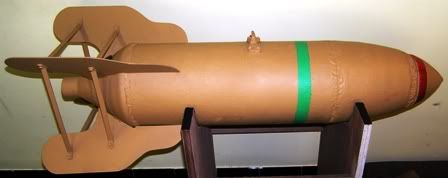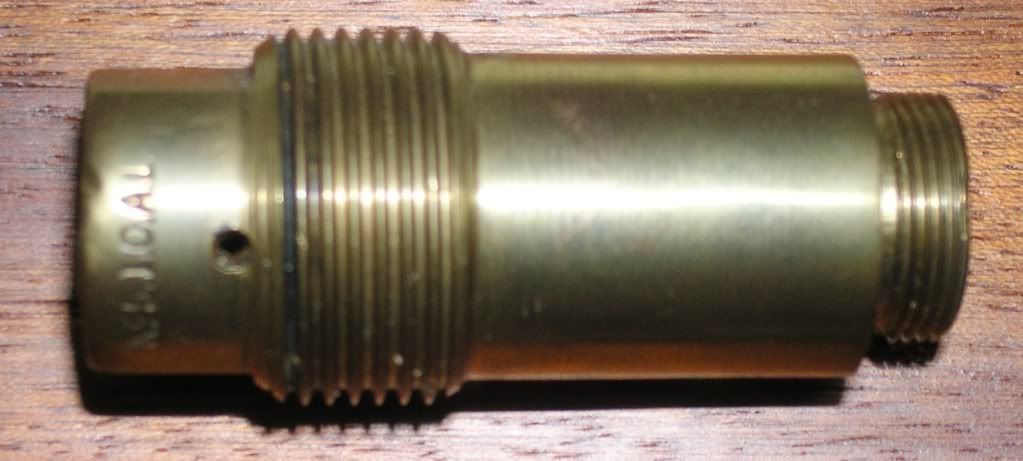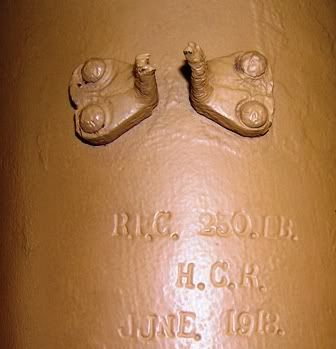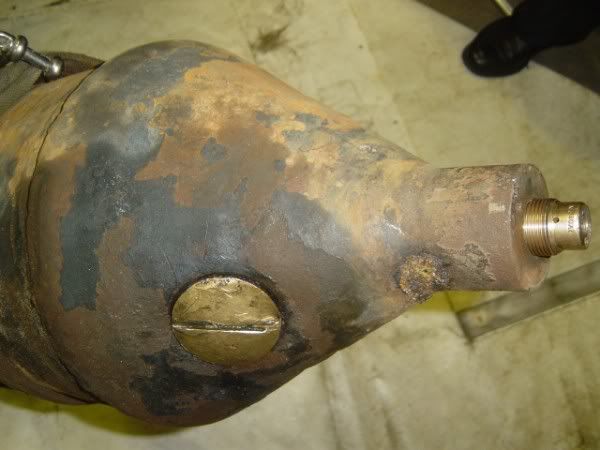British Ordnance Collectors Network
You are using an out of date browser. It may not display this or other websites correctly.
You should upgrade or use an alternative browser.
You should upgrade or use an alternative browser.
230
- Thread starter taucher
- Start date
What normaly is a straight forward job,the removal of a Nr.5 pistol turned out something pretty different.After removal of the Nr5 pistol there whas something else in there.What the f.......... oh:
oh:
Under the Nr5 whas a other pistol.What whas it?Nobody of us hase ever seen this before in this combination.No booster under the pistol but...........one other pistol.And what a pistol!
A long delay pistol and anti-withdrawel!
It looks like the Nr17 pistol but it is not the 17.
Its a Nr20 Mc Alpine pistol!Never in the history of the Belgium EOD has this been found!There are no books known to us discribing this combination.Better stil, nothing known about the Mc Alpine!
Here it is

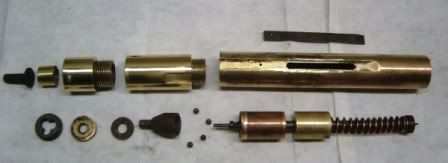
Under the Nr5 whas a other pistol.What whas it?Nobody of us hase ever seen this before in this combination.No booster under the pistol but...........one other pistol.And what a pistol!
A long delay pistol and anti-withdrawel!
It looks like the Nr17 pistol but it is not the 17.
Its a Nr20 Mc Alpine pistol!Never in the history of the Belgium EOD has this been found!There are no books known to us discribing this combination.Better stil, nothing known about the Mc Alpine!
Here it is


WOW :neutral: that must have been a shocker :tinysmile_eyebrow_t
Hello,
Something new about this assembly ?
Regards
http://www.bocn.co.uk/vbforum/threads/43946-McAlpine-Long-Delay-Pistol?highlight=McAlpine
Something new about this assembly ?
Regards
http://www.bocn.co.uk/vbforum/threads/43946-McAlpine-Long-Delay-Pistol?highlight=McAlpine
Last edited:
Bellifortis
Well-Known Member
McAlpine
Hallo,
I'm also very interested to hear more about this. I have never heard about the No. 20 Mc Alpine pistol. The No.20 pistol is something different. In the case mentioned above, was the No.5 pistol used to crush the acetone ampule and start the delay ? I have only once seen mentioning of the McAlpine fuze in the book by Ian Jones "Malice Aforethought". I attach the picture from there. For many years I try to trace the development of the AC delay and the H2SO4 / ironwire delay. I was not able to find anything before 1917. Also the above bomb dates to 1917. Thank you Norman for naming the 2 Mc Alpine patents which I did not know. Any further info would be much appreciated.
Regards,
Bellifortis.
Hallo,
I'm also very interested to hear more about this. I have never heard about the No. 20 Mc Alpine pistol. The No.20 pistol is something different. In the case mentioned above, was the No.5 pistol used to crush the acetone ampule and start the delay ? I have only once seen mentioning of the McAlpine fuze in the book by Ian Jones "Malice Aforethought". I attach the picture from there. For many years I try to trace the development of the AC delay and the H2SO4 / ironwire delay. I was not able to find anything before 1917. Also the above bomb dates to 1917. Thank you Norman for naming the 2 Mc Alpine patents which I did not know. Any further info would be much appreciated.
Regards,
Bellifortis.
Attachments
Hallo,
I'm also very interested to hear more about this. I have never heard about the No. 20 Mc Alpine pistol. The No.20 pistol is something different. In the case mentioned above, was the No.5 pistol used to crush the acetone ampule and start the delay ? I have only once seen mentioning of the McAlpine fuze in the book by Ian Jones "Malice Aforethought". I attach the picture from there. For many years I try to trace the development of the AC delay and the H2SO4 / ironwire delay. I was not able to find anything before 1917. Also the above bomb dates to 1917. Thank you Norman for naming the 2 Mc Alpine patents which I did not know. Any further info would be much appreciated.
Regards,
Bellifortis.
i will try to put something together on the McAlpine fuzes, meanwhile a few notes. There were two distinct Land Service requirements for a long delay (LD) fuze in 1918. The first was for 'stock denial' operations whereby several LD fuzed munitions would be left in an ammunition dump if swift retirement was necessary. The fuze shown in Ian's very splendid book fits a Stokes 3-inch mortar bomb which could be hand initiated by breaking the acetone phial and left in a stack of ammunition. The second requirement was for a LD fuze that could be fired in a projectile. The above fuze could be fired with a Stokes mortar bomb but a more robust body was required for use with artillery projectiles. No 101 fuze bodies were supplied to McAlpine for adaptation to LD fuzes employing his AC mechanism.
In Naval Service the McAlpine fuze that fitted the Stokes mortar bombs was used with smoke floats to delay the emission of smoke.
The McAlpine fuze design was used as the basis for the No 17 LD pistol for use in the Air Service. I believe this development was started in the early 1920s. I do not know about the 'No 20' McAlpine pistol.
From 1918 work continued to develop LD fuzes. Chemical delay, mechanical time (clock) and electrolytic delay mechanisms were experimented with.
[I have used the term McAlpine "Fuze" rather than pistol because it is referred to as such in official correspondence of the period]
McAlpine Fuze
Further to yesterday's note I have looked at a few references.
Seemingly a McAlpine fuze was tested with aerial bombs such that a report was seen by the Ordnance Committee as early as December 1917 - no actual details given.
Below are a photograph and diagram of the 'fuze' shown in Ian's book. The official designation of this device is, by August 1918, Pistol, Mine, Long Delay, Mark I /L/. As I said it fits on the Stokes 3-inch Mortar Bomb for stock denial purposes and I said it could also be fired but looking at the rather meagre pin holding back the spring-loaded striker I would not have thought it advisable to fire the bomb with the pistol fitted.




Further to yesterday's note I have looked at a few references.
Seemingly a McAlpine fuze was tested with aerial bombs such that a report was seen by the Ordnance Committee as early as December 1917 - no actual details given.
Below are a photograph and diagram of the 'fuze' shown in Ian's book. The official designation of this device is, by August 1918, Pistol, Mine, Long Delay, Mark I /L/. As I said it fits on the Stokes 3-inch Mortar Bomb for stock denial purposes and I said it could also be fired but looking at the rather meagre pin holding back the spring-loaded striker I would not have thought it advisable to fire the bomb with the pistol fitted.




Bellifortis
Well-Known Member
Hi Norman,
thanks for the additional info. So, considering all this info, McAlpine seems to be the inventor of the AC delay and the timeframe lies between 1915 and 1917. What about the corrosion of an ironwire by Sulphuric Acid delay (the US / GB time pencil being a development of this system). I asked about this before, but have not found an answer. By 1917 Germany, France and Finland were using this system, but where did it originate ?
Regards,
Bellifortis.
thanks for the additional info. So, considering all this info, McAlpine seems to be the inventor of the AC delay and the timeframe lies between 1915 and 1917. What about the corrosion of an ironwire by Sulphuric Acid delay (the US / GB time pencil being a development of this system). I asked about this before, but have not found an answer. By 1917 Germany, France and Finland were using this system, but where did it originate ?
Regards,
Bellifortis.
Hi Norman,
thanks for the additional info. So, considering all this info, McAlpine seems to be the inventor of the AC delay and the timeframe lies between 1915 and 1917. What about the corrosion of an ironwire by Sulphuric Acid delay (the US / GB time pencil being a development of this system). I asked about this before, but have not found an answer. By 1917 Germany, France and Finland were using this system, but where did it originate ?
Regards,
Bellifortis.
I would certainly credit McAlpine with the AC delay fuze (in the absence of new evidence to the contrary). I don't know who can claim to have invented the acid-wire delay fuze but as far as the time-pencil is concerned the first use of cupric chloride (as against an acid) was a claim by Commander A J Langley RN. The claim was allowed by the Royal Commission on Awards to Inventors after much challenging by Treasury Solicitors citing the acid-wire delay as the same thing - which it was found not to be. Langley devised the Time Pencil late 1938 / early 1939. The Time Pencil is subject to a few myths regarding its origins.
Best wishes.

